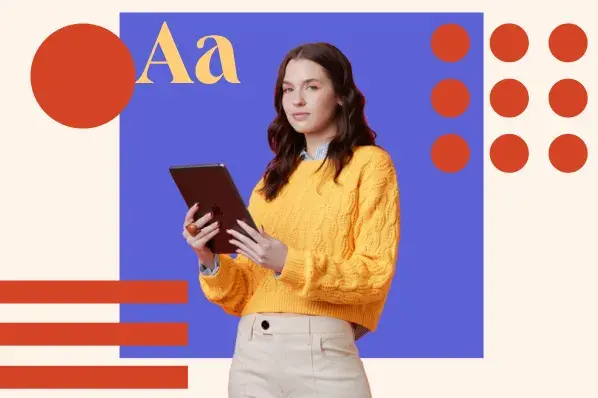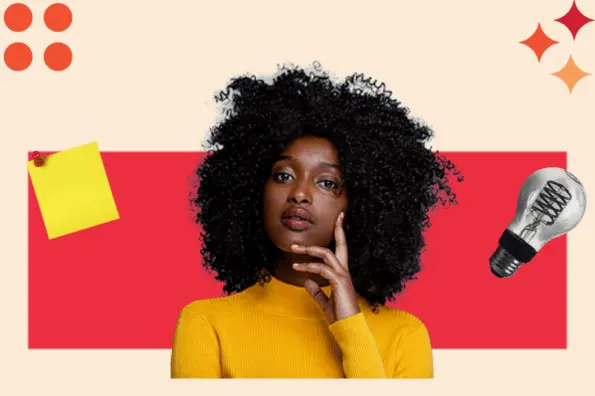In this post, we'll dive into what color fonts are, the potential drawbacks, why they are effective, and how you can use these typefaces to their fullest potential.
What are color fonts?
Color fonts are an inflection point for digital typography. And it's not as intimidating as it may seem: a color font file has a lot in common with a traditional one. Color font files, however, embed extra data that allows the font to display graphic properties. That additional information gives web designers more creative freedom to manipulate the font's appearance.
Even if you think you're unfamiliar with color fonts, you probably use them every day unknowingly. Emojis, for instance, are color fonts.
While you can use the term color font to describe graphic characters (hence emojis), it also often applies to a more traditional typeface. You should be aware of some hallmarks of color fonts: They permit color specification inside the font file itself. Thanks to color fonts, your type can have multiple textures, shades, colors, and transparency. Color fonts also include bitmap images, vector shapes, or both.
Color fonts also differ from traditional ones because they allow you to add multiple colors to your characters. You can find Google color fonts by visiting the Google Fonts homepage and selecting 'Show only color fonts.'

Other Names for Color Fonts
Today, we usually store color fonts as Scalable Vector Graphics (SVG) data which you can find in OpenType font files. This format is effective as SVG can contain vector shapes that include gradients, color, and even bitmap images.
For this reason, you may hear color fonts called OpenType-SVG or chromatic fonts.
History of Color Fonts
You can credit the OpenType-SVG font format to Adobe and Mozilla. These companies initially created the form that became the industry standard in 2016. Other massive companies such as Google and Microsoft agreed to the single format that supports color fonts.
All of these companies, however, previously implemented their own color formats to show emojis on their operating systems. Today, there are five main color font formats. These include SVG (W3C), SBIX (Apple), CBDT (Google), and COLR (Microsoft), OpenType SVG (Mozilla & Adobe).
OpenType-SVG is gaining momentum because multiple operating systems support it.
Are there any drawbacks to using color fonts?
All of that sounds great, right? However, some potential drawbacks could prevent designers from adapting color fonts in their designs. Let's dive into two things you should consider when you are thinking about using color fonts: font scalability and size.
Let's share the good news: If the color font you're using is based on vector glyphs, you can resize them without losing quality.
However, if you're working with a color bitmap font, it can scale correctly up to a specific size. If it's beyond its original resolution, the lettering will appear pixelated.
You may also be curious about font sizes. Color font files are usually larger than traditional ones would. This concern is amplified if the font embeds bitmap characters that are high-res.
Fonts are usually several hundred kilobytes. However, color fonts weigh significantly more (depending on how complicated they are). Some may be a megabyte or more.
Why do web designers use color fonts?
Web designers use color fonts to create a more visually appealing digital experience. Here are some primary reasons web designers will harness the power of color fonts.
Color fonts add visual interest.
If you're a web designer looking to add visual interest to ensure your copy pops, color fonts are a great option. Of course, that means you have to learn to use them correctly — but more on that later.
Whereas a traditional font is relatively limited in what colors it contains, you can get creative with color fonts to add visual complexity to your copy. With the help of color fonts, you can embellish your fonts in a way previously unthinkable.
Notice how, with the example below, the font has more character than it would if it were flat.

Color fonts are highly customizable.
Another reason color fonts are popular is that they're customizable. Your web designer can create a font that reflects your copy accurately by adjusting the colors, shades, transparency, and textures.
While color fonts offer more personalization than traditional fonts, they're still just as readable (when done correctly).
Color fonts are compatible with copy-and-paste, find-in-page, and screen readers.
Before color fonts, if you wanted to create visually appealing text, you'd have to use graphic images. However, there were some limitations with graphic images. Now, with color fonts, you can rest assured that your font is compatible with copy and paste, screen readers for accessibility, and the ever-popular find-in-page feature.
Color fonts are flexible.
If your text doesn't load correctly, don't worry. Color fonts display fallback text that allows your site visitors to read your copy. Google research reveals that over half of mobile visitors abandon your site if it doesn't load in three seconds; imagine if your text didn't load. You'd have many people leaving, resulting in a higher bounce rate. Luckily, designers created color fonts with a backup plan in mind.

Tips on Using Color Fonts
Now that you understand why color fonts are an excellent choice for web designers, let's run through some tips and tricks for using them to their fullest potential.
Don't overuse color fonts.
Think of color fonts as the cherry on top of your ice cream sundae; A happy add-in, not a necessity. Color fonts are not here to replace the traditional single-color typeface we use daily. Imagine how overwhelming reading this blog post would be if every letter had various textures and colors. Less is more.
Ensure your color fonts pop against the background.
For visual and accessibility purposes, your font must pop against the background. When choosing colors to form the base of the letters, make sure they appear clearly enough. Then, you can add other decorative elements that have less contrast.
Use the font's palette to gain insight into which colors to use.
One of the perks of using a color font is that they're highly customizable. However, you want to ensure that all of your components still flow together seamlessly. To do so, look at the color palettes the designer created for insight into how the different facets of the font relate. Then, make your adjustments.
Use Color Fonts to Add Visual Interest
Now that you have a robust understanding of color fonts and how to use them, head to Google fonts (or your font provider of choice) and get started working with them.

.jpg)



![All the Image Sizes You Need to Know For Your Website [+Tips and Insights]](https://53.fs1.hubspotusercontent-na1.net/hubfs/53/image-size-for-website-1-20250205-643528.webp)



